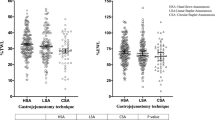Abstract
Background
Different anastomotic techniques have been evaluated during a laparoscopic Roux-en-Y gastric bypass (RYGB); however, no techniques have proven to be better than any other regarding complications and the percentage of weight loss (excess weight loss (%EWL)), and there are few controlled prospective studies to compare them.
Methods
A randomized, prospective study was conducted in 238 patients undergoing RYGB for morbid obesity between July 2008 and September 2012 to compare the early and late postoperative complications between the two surgical techniques: gastrojejunal hand-sutured anastomosis (HSA) and circular-stapled anastomosis (CSA). Minimum follow-up was 24 months.
Results
The two groups of patients were similar for demographic data and preoperative comorbidities. There were no significant differences between the surgical techniques regarding %EWL at 3, 12, and 24 months. The patients with CSA had a greater frequency of postoperative gastrointestinal bleeding (GIB) (4.2 vs. 0 %, p = 0.024) and surgical wound infection (11.1 vs. 3.4 %, p = 0.025) than the patients with HSA, with no significant differences in the other early complications. There were no significant differences in either group for late complications (gastrojejunal anastomosis (GJA) stricture, marginal ulcer, GJA perforation, bowel obstruction, and eventration). No significant differences were observed in operative time, rate of reoperation and postoperative length of hospital stay.
Conclusions
HSA and CSA were techniques with similar safety and effectiveness in our study. HSA had a lower rate of bleeding complications and surgical wound infection, although it does require greater experience in laparoscopic hand suturing.


Similar content being viewed by others
References
Laparoscopic sleeve gastrectomy versus laparoscopic Roux-en-Y gastric bypass for morbid obesity and related comorbidities: a meta-analysis of 21 studies. Zhang Y, Ju W, Sun X et al. Obes Surg. 2014.
Ruiz-de-Adana JC, López-Herrero J, Hernández-Matías A, et al. Laparoscopic hand-sewn gastrojejunal anastomoses. Obes Surg. 2008;18:1074–6.
Gonzalez R, Lin E, Venkatesh KR, et al. Gastrojejunostomy during laparoscopic gastric bypass: analysis of 3 techniques. Arch Surg. 2003;138:181–4.
Lee S, Davies A, Bahal S et al. Comparison of gastrojejunal anastomosis techniques in laparoscopic Roux-en-Y gastric bypass: gastrojejunal stricture rate and effect of subsequent weight loss. Obes Surg. 2014 [Epub ahead of print].
Madan AK, Harper JL, Tichansky DS. Techniques of laparoscopic gastric bypass: on line survey of American society of bariatric surgery practicing surgeons. Surg Obes Relat Dis. 2008;4:166–73.
Bandewald FP, Choi JN, Blythe LS, et al. Comparison of hand-sewn, lineal-stapled and circular-stapled gastrojejunostomy in laparoscopic Roux-en-Y Gastric bypass. Obes Surg. 2011;21:1671–75.
Abdel-Galil E, Sabry AA. Laparoscopic Roux-en-Y gastric bypass evaluation of three different techniques. Obes Surg. 2002;12:639–42.
Luján JA, Frutos MD, Hernández Q, et al. Laparoscopic versus open gastric bypass in the treatment of morbid obesity: a randomized prospective study. Ann Surg. 2004;239:433–7.
Lujan JA, Frutos MD, Hernández Q, et al. Experience with the circular stapler for the gastrojejunostomy in laparoscopic gastric bypass (350 cases). Obes Surg. 2005;15:1096–102.
Shope TR, Cooney RN, McLeod J, et al. Early results after laparoscopic gastric bypass: EEA vs GIA stapled gastrojejunal anastomosis. Obes Surg. 2003;13:355–59.
Ahmed B, Ammori BJ. The safety of laparoscopic hand-sutured gastrojejunostomy in gastric bypass for the treatment of morbid obesity. Obes Surg. 2013;23:1487–92.
Penna MBBS, Markar S, Venkat V, et al. Lineal-stapled versus circular-stapled laparoscopic gastrojejunal anastomosis in morbid obesity: meta-analysis. Surg Laparosc Endosc Percutan Tech. 2012;22:95–101.
Miller KA, Pump A. Use of bioabsorbable staple reinforcement material in gastric bypass: a prospective randomized clinical trial. Surg Obes Relat Dis. 2007;4:417–21.
Wittgrove A, Clark GW. Laparoscopic gastric bypass, Roux en Y 500 patients: technique and results with 3–60 month follow up. Obes Surg. 2000;10:233–9.
Kravetz A, Reddy S, Murtaza G, et al. A comparative study of handsewn versus stapled gastrojejunal anastomosis in laparoscopic Roux en Y gastric bypass. Surg Endosc. 2011;25:1287–92.
de Adana JC R, Hernández A, Hernández M, et al. Risk of gastrojejunal anastomotic stricture with multifilament and monofilament sutures after hand-sewn laparoscopic gastric bypass: a prospective cohort study. Obes Surg. 2009;19:1274–77.
Takata MC, Ciovica R, Cello JP, et al. Predictors, treatment, and outcomes of gastrojejunostomy stricture after gastric bypass for morbid obesity. Obes Surg. 2007;17:878–84.
Gould JC, Garren M, Boll V, et al. The impact of circular stapler diameter on the incidence of gastrojejunostomy stenosis and weight loss following laparoscopic Roux-en-Y gastric bypass. Surg Endosc. 2006;20:1017–20.
Sacks BC, Mattar SG, Qureshi FG, et al. Incidence of marginal ulcers and the use of absorbable anastomotic sutures in laparoscopic Roux en Y gastric bypass. Surg Obes Relat Dis. 2006;2:11–6.
D’Hondt MA, Pottel H, Devriendt. Can a short course of prophylactic low-dose proton pump inhibitor therapy prevent stomal ulceration after laparoscopic Roux en Y gastric bypass? Obes Surg. 2010;20:595–9.
Sasse KC, Ganser J, Kozar M, et al. Seven cases of gastric perforation in Roux-en-Y gastric bypass patients: what lessons can we learn. Obes Surg. 2008;18:530–4.
Conflict of Interest
The authors declare that there are no conflicts of interest
Author Contribution
Israel Abellán and Victor López: study design, data acquisition, and manuscript drafting; J. Abrisqueta, MD. Frutos, and Q. Hernández: data acquisition and manuscript drafting; Juan Luján: data acquisition, manuscript drafting, and statistical analysis; and P. Parrilla: data acquisition, manuscript drafting, and revision.
Author information
Authors and Affiliations
Corresponding author
Rights and permissions
About this article
Cite this article
Abellán, I., López, V., Lujan, J. et al. Stapling Versus Hand Suture for Gastroenteric Anastomosis in Roux-en-Y Gastric Bypass: a Randomized Clinical Trial. OBES SURG 25, 1796–1801 (2015). https://doi.org/10.1007/s11695-015-1638-2
Published:
Issue Date:
DOI: https://doi.org/10.1007/s11695-015-1638-2




